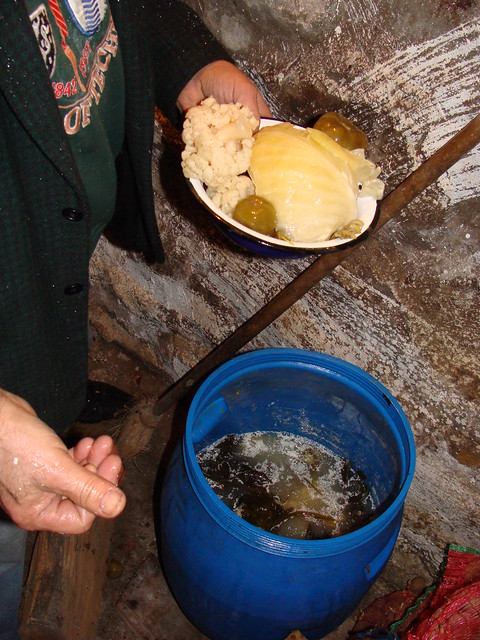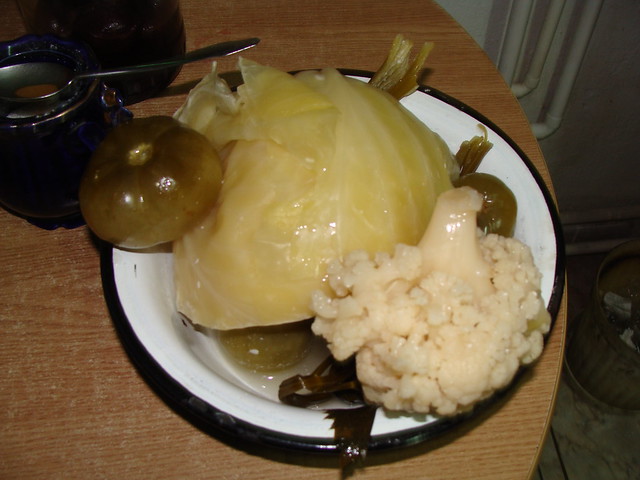by Paul White
Vegetables and fruit grown in the summer are not only consumed in season but are are also pickled and made into preserves for the winter months. These include gherkins, peppers, chillies, cabbage, tomatoes, and jam made from fruit. There has been quite a lot of interest in the diet of the Székely Hungarians recently, and I really had no idea how important pickled foods are during the winter months for a population that relies mainly on seasonal food. This page is dedicated to the pickling process and I will add further photographs and detail as I learn more about this traditional culinary skill.

A forum friend called Chris Parkinson with an interest in the history of pickling explains:-
"Sauerkraut was a staple for Attilla and the Horde. In addition to the fact that it is a great way of preserving food to take with you on your rape and pillaging trips, it is a great health food. Cabbage is rich in vitamin K and pickling boosts the K content. Pickles are rich in beneficial bacteria - so are a great probiotic. The natural enzymes are also enhanced by the pickling. The sauerkraut is a rich source of vitamin c - hard to get otherwise in the winter months. The traditional way of lacto fermenting pickles using just salt (and possibly some whey) was replaced in the west by pickling in vingegar which has none of the health benefits. (The vinegar kills the beneficial bacteria and the enzymes). I would really love to see some photos of the villagers doing their pickling to see how they do it."
In response to Chris's request I decided to pay a visit to some Szekely friends to learn more. The Ferencz family live a very traditional life and know a lot of the old methods for preserving food. Eva gave me the following instructions for pickling cucumbers:-
First wash the cucumbers, then place in a jar and fill with water. Then drain the water in one bowl and cucumbers in another. Add salt to the water to taste. Eva did not use table salt, it looked more like rock salt with large crystals. Then place dill, celery and Csombor leaves (summer savory) in the bottom of the empty jar. Then replace the cucumbers and the salty water.
The next process is personal choice. Eva prefers her pickled cucumbers crunchy, so she would do no more than outlined above, then place the jars in the cellar. The pickles would be ready in 2-3 weeks. However, for those that like soft pickles, the jar and contents would be placed on top of a cloth in a pan of cold water. Then wrap a small hand towel around the jar. Heat the water to boiling point then turn down to simmer for 10 minutes. Remove the jar and allow to cool. Then store in larder or cellar.

Eva's cellar is like an Alladins cave with jars of pickles everywhere. Her husband took me for a look around. She even has 100 litre plastic barrels full of mixed pickles and jars of all sizes.


Vegetables and fruit grown in the summer are not only consumed in season but are are also pickled and made into preserves for the winter months. These include gherkins, peppers, chillies, cabbage, tomatoes, and jam made from fruit. There has been quite a lot of interest in the diet of the Székely Hungarians recently, and I really had no idea how important pickled foods are during the winter months for a population that relies mainly on seasonal food. This page is dedicated to the pickling process and I will add further photographs and detail as I learn more about this traditional culinary skill.

A forum friend called Chris Parkinson with an interest in the history of pickling explains:-
"Sauerkraut was a staple for Attilla and the Horde. In addition to the fact that it is a great way of preserving food to take with you on your rape and pillaging trips, it is a great health food. Cabbage is rich in vitamin K and pickling boosts the K content. Pickles are rich in beneficial bacteria - so are a great probiotic. The natural enzymes are also enhanced by the pickling. The sauerkraut is a rich source of vitamin c - hard to get otherwise in the winter months. The traditional way of lacto fermenting pickles using just salt (and possibly some whey) was replaced in the west by pickling in vingegar which has none of the health benefits. (The vinegar kills the beneficial bacteria and the enzymes). I would really love to see some photos of the villagers doing their pickling to see how they do it."
In response to Chris's request I decided to pay a visit to some Szekely friends to learn more. The Ferencz family live a very traditional life and know a lot of the old methods for preserving food. Eva gave me the following instructions for pickling cucumbers:-
First wash the cucumbers, then place in a jar and fill with water. Then drain the water in one bowl and cucumbers in another. Add salt to the water to taste. Eva did not use table salt, it looked more like rock salt with large crystals. Then place dill, celery and Csombor leaves (summer savory) in the bottom of the empty jar. Then replace the cucumbers and the salty water.
The next process is personal choice. Eva prefers her pickled cucumbers crunchy, so she would do no more than outlined above, then place the jars in the cellar. The pickles would be ready in 2-3 weeks. However, for those that like soft pickles, the jar and contents would be placed on top of a cloth in a pan of cold water. Then wrap a small hand towel around the jar. Heat the water to boiling point then turn down to simmer for 10 minutes. Remove the jar and allow to cool. Then store in larder or cellar.

Eva's cellar is like an Alladins cave with jars of pickles everywhere. Her husband took me for a look around. She even has 100 litre plastic barrels full of mixed pickles and jars of all sizes.

